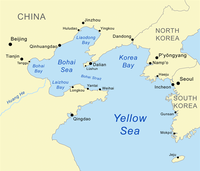
Photo from wikipedia
To solve the water use conflicts between agriculture and ecosystems in arid and semiarid areas, a multi-objective trade-off analysis method was applied to determine the environmental flows (e-flows) for the… Click to show full abstract
To solve the water use conflicts between agriculture and ecosystems in arid and semiarid areas, a multi-objective trade-off analysis method was applied to determine the environmental flows (e-flows) for the Yellow River Estuary, by considering the temporal and spatial discrepancies in water allocation. The results showed that during average years, a loss of 3.7 × 108 yuan was caused with every 1 × 108 m3 of e-flows under the baseline scenario. The crop growth stages of April–July are sensitive periods for water requirements, and over 5000 yuan/ha production losses were caused by prioritizing e-flows during this time in dry years. The stages from July–October require more water by ecosystems than other stages, and the recommended e-flows during this time accounted for 57% of the e-flows during the total year. Under scenarios 1–3, which represent the short-term, medium-term and long-term scenarios, more water resources were supplied by underground water and water diversion projects; however, alleviating the water use contradiction remained difficult in dry years. During average years, e-flows between 148 and 168 × 108 m3 are recommended to meet the ecological objectives of survival, reproduction and biological integrity of species for the Yellow River Estuary. The recommended e-flows in wet years could meet higher ecological objectives but still barely achieve the targets of sediment transport and ecosystem dynamic balance. In dry years, the economic losses may be beyond the acceptance of irrigation stakeholders if more water is allocated to improve e-flows. In this case, 71 × 108 yuan would be paid to them to compensate for their losses. This study proposes an e-flow recommendation framework that is economically and ecologically optimal in areas with irreconcilable water-use contradictions.
Journal Title: Agriculture
Year Published: 2021
Link to full text (if available)
Share on Social Media: Sign Up to like & get
recommendations!